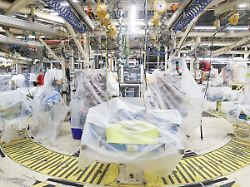The situation on the Russian labor market is more than tense. Many companies are looking for skilled workers. The desperation is so great: even convicts are now committed. Not only do they pose an enormous security risk, they don’t even begin to solve the problem.
In Russia, a number of companies are desperately looking for staff. Recently, the Lada manufacturer Avtovaz has even requested prisoners who have been sentenced to forced labor to close the gaps in their workforce because of the acute shortage of workers. This step has become necessary for the car manufacturer for one reason in particular: the Russian labor market is practically full. In April, unemployment fell to a record low of 3.3 percent.
Even if the shortage on the Russian labor market is enormous: Alexander Libman, an Eastern Europe expert from Freie Universität Berlin, has serious doubts that Avtovaz’s approach will find many imitators. “Prisoners are extremely unproductive and unreliable. For most companies, they will be more of a burden,” says the political scientist in an interview with ntv.de. Furthermore, according to political scientist and expert on the post-Soviet space, Gerhard Mangott, there is no legal basis for a prisoner to be hired by a private contractor. In addition, it is a safety risk for a company to have prisoners work for it.
Similar to Libman, Mangott assumes that prison inmates tend not to be the highly qualified professionals that are needed in many key industries. “As positive as the low unemployment rate sounds, it says little about the sectors in which there is a shortage of qualified workers,” says Mangott in an interview with ntv.de. Instead of replacing qualified workers with prisoners, it would be better to think about ways of bringing back Russians who have emigrated. One possibility, which according to information from the political scientist is already being discussed in government circles, is a guarantee that they cannot be mobilized after their return. “I think such a promise would be more effective than resorting to prisoners,” Mangott continued.
The labor market situation is helping inflation
Hundreds of thousands of men were drafted into the military as a result of the Ukraine war and many others fled abroad as a result of the tense situation on the labor market. It is estimated that more than a million Russians have left the labor market because they were posted to the front or because they fled the country. Before the war in Ukraine, the unemployment rate in January 2021 was almost six percent. Libman emphasizes: “Even before the war, Russia was a country with a severe labor deficit. Emigration and mobilization have made the situation significantly worse.” He assumes that the labor deficit will remain a problem for the Russian economy in the long term.
While Russia’s central bank is warning that labor market conditions are playing into the hands of inflation, government officials continue to sell high levels of employment to the public as a sign of a healthy economy. A recent survey by the central bank of 14,000 Russian companies revealed just how urgently the Russian labor market lacks qualified specialists: According to this, the availability of workers has fallen to minus 18 percent. This is the lowest value since data collection began in 1998, as reported by the newspaper Kommersant.
Russian President Vladimir Putin is also aware of this: “One of the most important issues at the moment is overcoming the staff shortage,” the TASS news agency quoted the Kremlin boss as saying in April. According to Putin, three main tasks must be solved in order for the situation on the labor market to ease. Firstly, the potential from regions where the unemployment rate is still high should be used. Second, the economy and the social sector can rely on lean production and automation technologies. Thirdly, investment in the training of specialists in the most sought-after professions would have to increase. In particular, engineering schools are to be expanded and new universities created, Putin said, according to TASS.
Despite the record low, business owners surveyed by the central bank were optimistic that seasonal trends will attract workers again in the coming months. But even that would not relieve the labor market. Because not only the emigration contributes to the current shortage of skilled workers. The unemployment rate is also so low because there are generally fewer people registering as unemployed in Russia than in Western European countries, as there is hardly any social support. In addition, the Russian population has been shrinking for years.
Russia is far from being an immigration country
The demographic dip is big. Russia will struggle to maintain its population level without significant immigration. According to a study by the Higher School of Economics (HSE) in Moscow, one million new migrants will have to immigrate to Russia every year by the end of the century in order to maintain current population levels.
Figures from the state statistics agency Rosstat show that Russia is far from being a country of immigration. While 430,000 people immigrated to Russia in 2021, in 2022 there were only 61,900. What is particularly explosive about the HSE forecast is that the survey does not take into account the enormous exodus of Russian citizens after the country invaded Ukraine.
According to Libman’s assessment, even the end of the war would not ease the situation on the labor market. “In the long term, the situation on the labor market will even worsen because of the low birth rates, which are falling even more due to the war.” The current labor market crisis has long been permanent. Unlike Putin, the Eastern Europe expert does not assume that technological innovations that could defuse dependency on labor will increase the country’s productivity. The sanctions are too effective for that.
